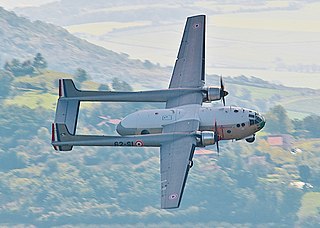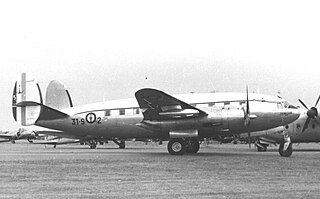
The Dassault MD 315 Flamant is a French light twin-engined transport airplane built shortly after World War II by Dassault Aviation for the French Air Force.

The Fouga CM.170 Magister is a 1950s French two-seat jet trainer aircraft that was developed and manufactured by French aircraft manufacturer Établissements Fouga & Cie. Easily recognizable by its V-tail, almost 1,000 have been built in France and under licence in West Germany, Israel, and Finland.

The Nord Noratlas was a dedicated military transport aircraft, developed and manufactured by French aircraft manufacturer Nord Aviation.

The Aérospatiale N 262 is a French twin-turboprop high-wing airliner built first by Nord Aviation. The aircraft was also known as the Nord 262.

The Turbomeca Marboré is a small turbojet engine that was produced by Turbomeca from the 1950s into the 1970s. The most popular uses of this engine were in the Fouga CM.170 Magister and the Morane-Saulnier MS.760 Paris. It was also licensed for production in the United States as the Teledyne CAE J69.

The Sud-Ouest S.O.30 Bretagne was a 1940s French airliner built by Sud-Ouest.

The Turbomeca Palas is a diminutive centrifugal flow turbojet engine used to power light aircraft. An enlargement of the Turbomeca Piméné, the Palas was designed in 1950 by the French manufacturer Société Turbomeca, and was also produced under licence by Blackburn and General Aircraft in the United Kingdom and Teledyne Continental Motors in the United States as the Continental Model 320.
The Fouga CM.88 Gemeaux was a 1950s French engine test-bed aircraft produced by Fouga. An unusual aircraft, it was two aircraft joined by a common wing.

The Fouga CM.8 or Castel-Mauboussin CM.8 was a French sailplane of the 1950s, most notable in retrospect due to its place in the development of the Fouga CM.170 Magister jet trainer.
Fouga was a French manufacturing company established by Gaston Fouga at Béziers during 1920. Originally specialising in the repair of railway rolling stock, the firm eventually became most noted for the aircraft it produced from its woodworking facilities at Aire-sur-l'Adour.

The Dassault MD.415 Communauté was a 1950s French twin-engined light turboprop transport monoplane built by Dassault Aviation. Only one prototype was built and flown.

The Potez 840 was a 1960s French four-engined 18-passenger executive monoplane, the last aircraft to use the Potez name.

The SNCAC NC.211 Cormoran was a large four-engined military transport aircraft for passengers and cargo designed and built by SNCAC from 1945.

The Sud-Ouest Corse was a French mail and passenger transport aircraft, built by SNCASO.
The Nord 2100 Norazur was a 1940s French military transport monoplane designed and built at Courbevoie near Paris by SNCAN.
The Bréguet 890 Mercure was a late 1940s French cargo and passenger transport aircraft designed by Bréguet Aviation. Three variants were produced including a military variant called the Mars but none entered production.

The Nord 260, built in prototype form as the Max Holste MH.260 Super Broussard,, was a turboprop-powered, uprated version of the piston-engined Max Holste MH.250 Super Broussard, that was further developed into the Aérospatiale N 262.
The Turbomeca Piméné was a small French turbojet engine produced by Turbomeca in the early 1950s.
The SIPA S.70 was a late 1940s French eight-passenger light transport aircraft prototype built by Société Industrielle Pour l’Aéronautique (SIPA).
The Morane-Saulnier MS-700 Pétrel was a French four-seat cabin-monoplane designed and built by Morane-Saulnier, only three prototypes were built.













